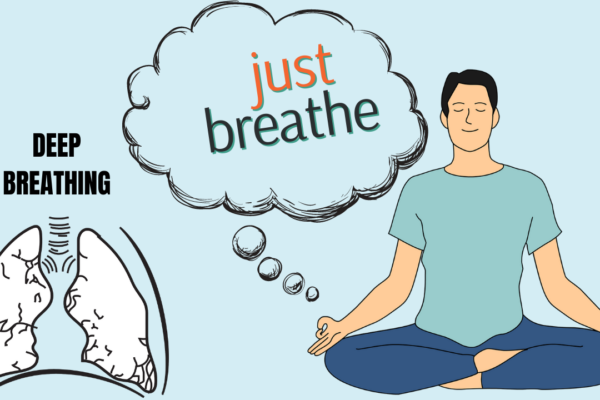In this episode, I am going to teach you how to decrease intrusive thoughts causing anxiety, by using an intervention called a Worry Journal.
In this series, I will be covering coping skills for anxiety that are cornerstone interventions in mental health.
All of the interventions mentioned here are best performed under the supervision of a mental health professional and are presented here for educational and entertainment purposes only.
As always, I aim to teach you actionable coping skills for strengthening your mental health, gaining focus and succeeding at life.
In this series, I will be discuss the following coping skills for anxiety.
1. The Worry Journal
2. Habituation
3. Deep Breathing and Progressive Muscle Relaxation
4. Anxiety scales (7 series)
5. Mindfulness/Grounding
6. And more (stay tuned).
In this episode, I am covering:
- The Worry Journal: A coping skill for decreasing your intrusive thoughts causing you anxiety.
How it works:
To understand how a worry journal is effective in decreasing intrusive thoughts, first we need to be clear on what anxious thoughts are about.
Anxious thoughts are often referred to as intrusive thoughts.
When I think of something that is intrusive, I get in touch with that feeling of having my flow interrupted. LIke a fly that just keeps getting in my face when I am trying to concentrate.
I find it very frustrating to lose traction in my train of thought when I am in my zone of genius, or a rhythm in my routine, even in the most seemingly mundane of tasks, like the dishes and laundry (passive tasks in which I the opportunity to find inspiration and reflect on my goals, usually in the form of podcasts).
Anxious thoughts do not ask for permission, or say “excuse me”, they just butt right in, and derail the quality of life you are trying to experience in the present moment, be it a conversation with a friend, or just trying to relax at home.
I am sure you can relate.
Intrusive definition: “Causing disruption or annoyance through being unwelcome or uninvited.” (Oxford Languages).”
I feel like the above definition really nails it. An “uninvited” guest.
Furthermore, anxious thoughts are not just abrupt, they are often unrelated to the context of our present circumstance and dialogue.
They hitchhike on a single word, trigger or thought, and then hijack our train of thought, attempting to take us on a roller-coaster ride in which we had no intention of taking.
You see, the thing about anxious thoughts, is that they can come on in an instant, yet flavor our mood for the day, causing a kind of domino effect on our thought process, which then impacts our reactions to the occurrence around us, be it our kids, spouse or friends.
This is because our anxious thoughts play off of our autonomic nervous system (via the fight or flight response, and the subsequent pathways of the sympathetic nervous system and the HPA Axis, which is to say they play off our fears.
You can learn more about this anxiety stress response in THIS ARTICLE by Harvard Health.
Now, this would be a good thing if we were in fact in real danger, but is most cases with anxiety, there is no imminent threat and it really amounts to wasted energy. Energy that could have otherwise gone to making headway toward other meaningful goals and spending quality time with loved ones.
Mindfulness for intrusive thoughts: The good news is that we can “tap the breaks” on our stress response by using biofeedback to activate our parasympathetic nervous system (“rest and digest response”).
Anxiety robs us of the ability to be present, which has a significant impact on our quality of life. MIndfulness exercises (Such as deep breathing, progressive muscle relaxation, Thi-Chi, guided meditations and exercise) can help to bring us back to the present, as well as condition us to ground ourselves in time of stress faster to short-stop our stress response.
Intrusive thoughts treatment: There are several staples in counseling that target anxious thoughts, but I would like to share with you one of the more prominent ones I have found helpful, which is the Enter the “Worry Journal”, which is an ideal intervention for decreasing intrusive thoughts.
This is not a typical long-form journal. It is not intended for processing your feelings and thoughts like a mood journal.
Rather, it is intended to be a concise exercise of writing down specific intrusive thoughts, with the intention of addressing them at a later time, in an organized fashion.
The concept of the worry journal stems from cognitive behavioral therapy.
The premise with this intervention is that you keep a worry journal where you jot-down, verbatim, the intrusive worrisome thoughts you experience, and then set a time during the day or week to review them, only to pose possible solutions in bullet point fashion.
Then, anytime you have a distressing thought, you remind yourself that you have an “appointment” to address it, and put your mind to rest, coming back to the present task at hand.
While brainstorming plausible solutions to the identified concern, it is important that you do so without attaching judgement to them, and once you have a decent selection of bullet-point solutions, then you can prioritize them in order of most feasibility/efficacy, and commit to trying out ONE of them at a time for that day, or week.
I like to use the mental images of my thoughts being on a conveyor belt, where I can just observe them passing by and picking up the ones I feel like attending to, and just noticing other others, saying to myself, “I know what you are about, but I am not interested in addressing you right now.”
Overcoming unwanted intrusive thoughts: This is a habit and skill that takes time and consistent practice to become proficient at, like any other skill worth learning. Learning to decrease intrusive thoughts is a skill you can develop.
Why do intrusive thoughts stick?
There is a saying in psychology, “what fires together, wires together.” Our brains create neural-pathways that are made up of neurons linked together via dendrites, that over time create grooves that become a kind of trail that are akin to paths our minds take to walking.
While challenging our thoughts may seem difficult in the beginning, overtime our minds will forge new pathways and become less resistant to the new way of thinking and responding to stimuli, triggers and intrusive thoughts.
You can learn more about the Neuroscience of behavior change here.
The goal with the worry journal is to target irrational thoughts or tangible concerns. In the event of irrational thoughts, to combat them and replace them with more helpful and accurate ones, and with the latter, to engage in problem solving from a place of empowerment toward resolve, thus increasing a sense of competency and adequacy to address future challenges and dismiss unhelpful thoughts.
Examples of irrational thoughts of anxiety would be statements of absolution (eg. “I will never, I am always, etc…). They are often referred to as “harmful thinking habits” in cognitive behavioral therapy, which I cover in other posts.
Your can see a list of common intrusive thoughts pdf in my free MOOD SCALE TRACKING TOOL.
Rumination versus intrusive thoughts: Rumination refers more to depression and regret over the past and our role in a particular loss. Intrusive thoughts involve worrying about events that have not yet happened, what is sometimes coined as “future tripping.”
If we are to decrease intrusive thoughts, than we must learn to catch our thoughts in action.
For those struggling with anxiety, intrusive thoughts are fear-based and usually magnified tenfold to anticipated worst-case-scenarios of outcomes that are not even the most likely to occur.
Why it works:
You are not your intrusive thoughts. The worry journal will bring light to the validity of your anxious thoughts, making it easier to identify them and mitigate their recurrence. This is how you decrease your intrusive thoughts.
Anxiety and consciousness: You see, when we have thoughts, we do not traditionally challenge them, unless we are trained to do so. We are not conditioned to think about our thinking, it is a dedicated exercise and skill that takes time to develop.
This means that we often take our thoughts at face value, even if they are not based in reality.
Anxiety stems from anticipated, unresolved concerns. Our natural instinct is to seek cognitive closure around those concerns.
However, in our brain’s attempt to gain this closure and problem solve, we often create more angst for ourselves, because our initial solutions create more branches of identified barriers or other related problems.
This produces fear and additional concerns that were not top of mind prior to the initial distressful thought. We end up with more concerns than we started out with, and this is not productive.
How to stop intrusive thoughts at night
Intrusive thoughts of worry are rarely timely, and interrupt our flow of daily living.
Our initial impulse is to chase them down (find immediate resolve), or push them away (“I don’t have time for this right now…I can’t deal with this thought”).
This poses two issues.
First, if we attempt to chase our thoughts down in an untimely manner, as mentioned above, then we get ourselves worked up with a futile effort to problem solve when we are distracted, and these attempts are usually more preoccupied with additional worries of worst-case-scenarios then they are with efforts to actually problem solve.
Second, if we seek to push our anxious thoughts away, then they tend to come back stronger and continue to disrupt our flow at other in-opportune times, such as when we are trying to sleep. To decrease our intrusive thoughts at night, we must make quiet time in the day.
The Worry Journal activity works because it allows for a planned, protected time, to reflect and meditate on our concerns, but from a constructive place, versus a place of fear and avoidance.
There are a multitude of things and people competing for our attention daily, and unless we plan a protected time to reflect and problem solve, the only quiet time we will be left with is when our heads hit the pillow, and that can lead to issues of insomnia which is a prevalent concern for those plagued with anxiety.
When it does not work:
The worry journal can be a very effective coping skill for anxiety, in particular for those struggling with a general form of anxiety, around tangible issues.
It is less effective for those dealing with specific forms of anxiety, such as phobias and panic disorders, compared to other interventions, such as habituation (exposure therapy) and de-escalation (deep breathing, mindfulness and grounding).
You can learn more about managing intrusive thoughts and ptsd here.
Put it to practice:
Choose your form of journal. It can be a pen and paper, a note app on your phone (my favorite is Google Keep Notes), or just your phone calendar notes. If you would like a dedicated journal with prompts, see the recommended journal at the bottom of this post.
Next, consider your schedule and commit to a time that works best for you. This could be a regular small block of time during your day, or a larger block once a week.
Note: Be sure to remember that this is a trial and error process, to learn and accept that there are many possible solutions, but you oftentimes have to try out several of them, before you see progress. This is about empowerment and taking a constructive, proactive stance in learning to decrease your intrusive thoughts.
There you have it, another tool for your toolbox.
Now, go make good things happen!
Try it out and let me know in the comments if you are finding this helpful and what form of journal works best for you.
Resources
- The anxiety and Worry Workbook
- Worry Journal
- Resource page
Recommended Reading


ASK: If you have a question you’d like me to answer here on the blog (even if you think it’s a silly one!), please use the form on the CONTACT ME page, or the comment section below. I would be happy to take a poke at it and provide a long form answer when appropriate.
SHARE: Also, be sure to share it with a friend, as there is still a lot of work to be done in raising mental health awareness.
SUBSCRIBE to get your FREE MOOD TRACKING TOOL and quick Mental Health Hacks in addition to this newsletter. Sign-up with the form below.
NEED CRISIS HELP? If you need immediate crisis help with your depression, you can call the National Suicide Prevention Lifeline at 1-800-273-8255 or text “START” to 741-741
OUTSIDE THE UNITED STATES: See International Suicide Hotlines
WHERE TO FIND MENTAL HEALTH HELP:
-NAMI Referral Helpline: 1-800-950-6264
-California’s Statewide Mental Health Helpline: 1-855-845-7415
admin
Latest posts by admin (see all)
- Thriving with Autism and ADHD: Expert Strategies for Managing Burnout - April 22, 2024
- Serial Killer Spotlight: Dr. Caparelli’s True Crime Analysis - April 14, 2024
- Donna’s Law: Stop Gun Suicides - March 22, 2024





